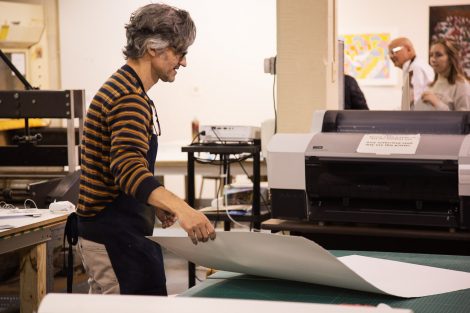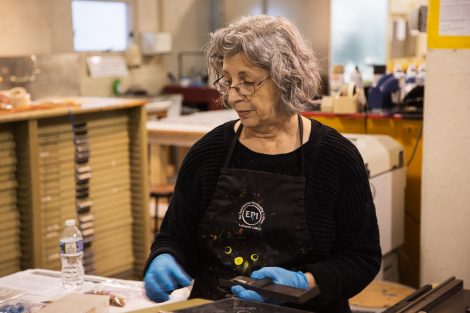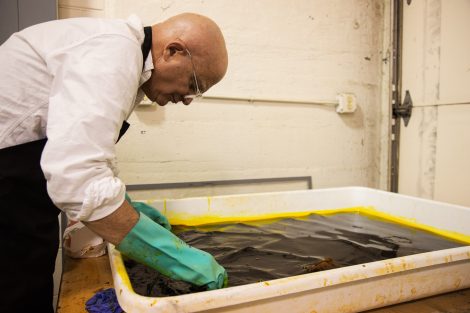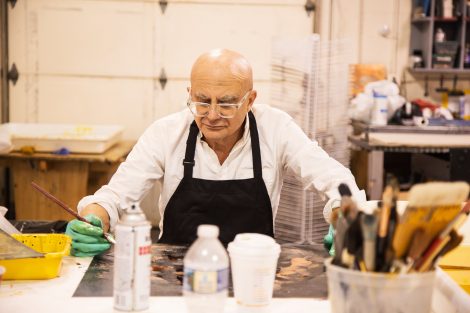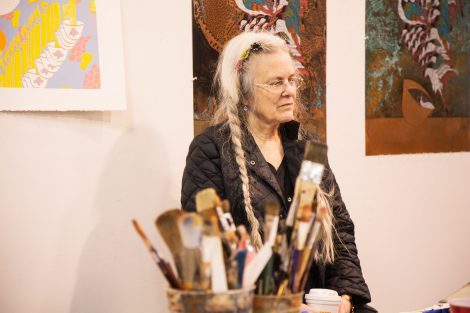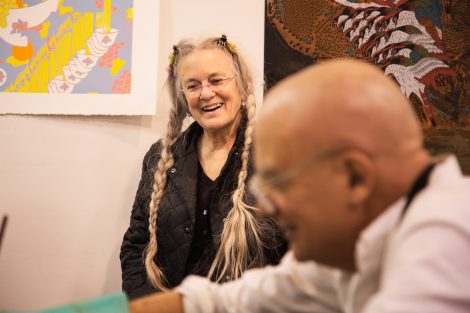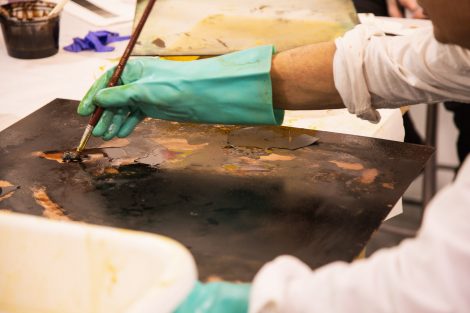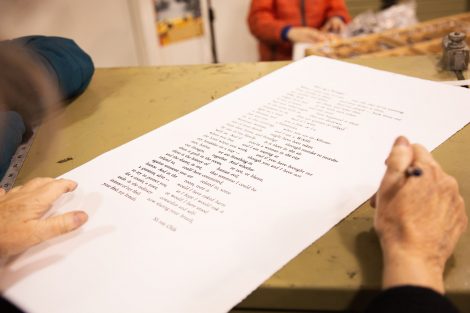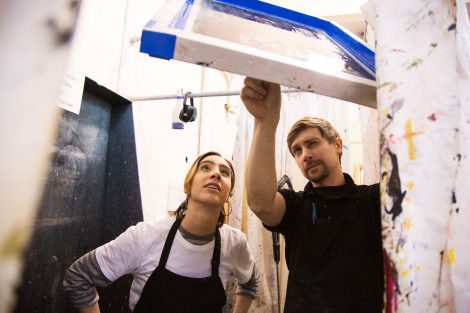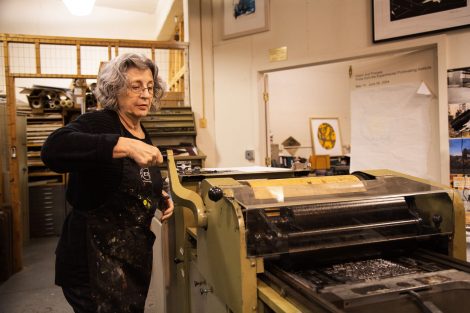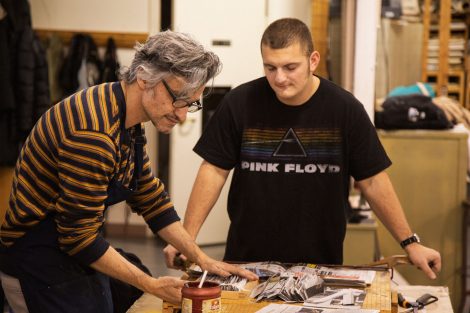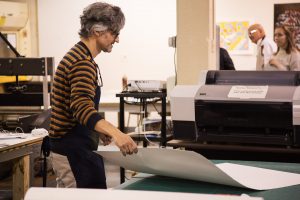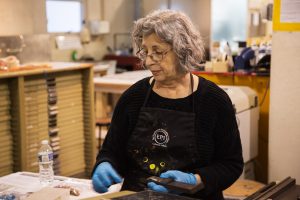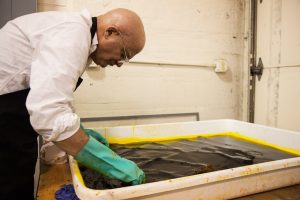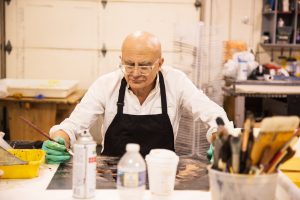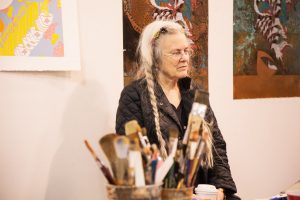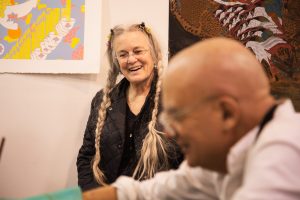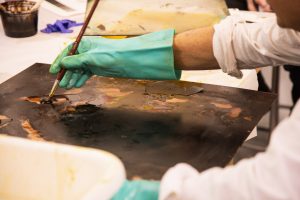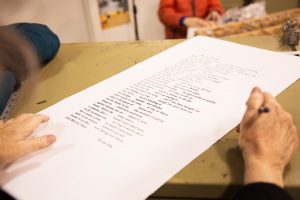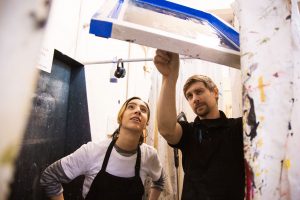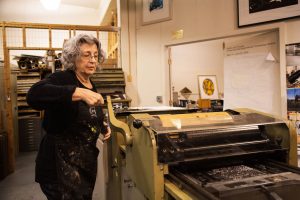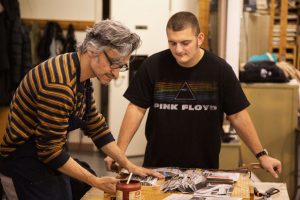Story by Stephen Wilson, photos by Clay Werzynowicz
A woman writes, legs elevated in what looks like a patio recliner, with a notebook and pen in hand. Across the room, a man in blue gloves scrubs with a circular motion a copper plate immersed in an acid bath.
Both are noted artists. Both are collaborating on the same project. And both have made Experimental Printmaking Institute (EPI) their home for the next 48 hours to work on an edition of broadsides.
That’s how long poet Sharon Olds and printmaker Sam Messer will strive to reach a final trial proof—something ready to pull.
The work of pulling final prints belongs to Pedro Barbeito, assistant professor of art and director of EPI, and his team.
Barbeito also pulled this project together, asking Pulitzer Prize winner Olds to contribute the words and Guggenheim fellow Messer to supply the images.
Through the 48-hour process, they will create a triptych of 36-by-24 prints that combine the poem with a screenprint and etched copper plates. The final prints will be for sale to help support future residency projects at EPI.
While time together to create such dramatic final art seems compressed, they have been talking about it for a while.
“Sam came over,” Olds says. “I was working on my next book, and the poem ‘Meeting a Stranger’ had been a favorite of mine. The poem seemed general enough, not merely personal, but a good collaboration poem.”
The poem outlines an encounter between Olds and an African American hotel worker.
“I’m an old-fashioned storyteller poet,” says Olds. “For a long time, I wouldn’t say if my work was autobiographical or not. I didn’t want to be judged or classified. Instead, I wanted to talk about my work as art—the line, image, and technique. I had taken a vow not to talk about my family or work in order to protect them. People wanted to know if my poems were about me, maybe because I write intimately as a woman.”
Messer remembers hearing this poem.
“She was reading so many amazing poems,” he says. “There was one called ‘Eight Moons’ I liked, but it was already so visual. I thought it would be too hard to do anything with it other than just illustrate, which I wasn’t interested in. When I heard ‘Meeting a Stranger,’ it was so profound and timely, just perfect for the moment. I knew I could make a poetic print from it—it was so layered, just like printmaking.”
Messer is etching two 26-by-26 copper plates—the seam between the two halves feels like that awkward yet charged moment between the two strangers in the poem. As he rubs the plate in the acid bath shadowy marks appear on the print in layers of color.
He also plans to place medallions in each corner of the print, harkening back to old maps. He wants viewers to consider how we move around in the world.
Across the room, artist MaryAnn Miller has inked the typeface and turned the crank of the letterpress. She then walks over with another draft of the poem. Olds pins it to the bulletin board along with the screenprint.
The poem appears to be written in two halves—split down the middle.
“The physical look of the poem on the page is important to me,” says Olds. “There are no stanzas anymore in my work. I want it jagged, like jazz, not as obedient. I remember as a 15-year-old when I discovered Fats Domino, Emily Dickinson, and Walt Whitman. It blew my mind.”
When Olds reads it, they discover errors. Miller circles typos—capitals, letters transposed, letters upside down—that she will then go back to fix.
Messer turns to Olds before returning to the acid bath. “I don’t get this opportunity too often,” he says. “An amazing poem like this means I have to work harder.”
Olds, almost mumbling to herself, says, “Doubt is part of the process—one stranger meeting another, one art form meeting another—if what we will make here will be of use.”
Like any chance encounter that relies on discovery, serendipity, questions, talking, and craft, there is a moment of fumbling until falling brilliantly into rhythm.
This room is filled with rhythm and rhyme—internal rhyme, just as Olds would want it.
